Chihuahua mix Miniature Pinscher: Chipin Dog Breed Information
The Chipin is a charming pup Chihuahua and Miniature Pinscher mix, known for its small size and energetic personality. These dogs have a short and smooth coat that comes in various colors. Chipins are alert and confident, making them great companions for apartment dwellers. They tend to be active but not overly so, which suits indoor living well.
When choosing a Chipin, a calm temperament is essential, especially if you live with close neighbors. These dogs can form strong bonds with their owners and, if appropriately introduced, get along with other pets. They are also low-maintenance in grooming, needing just regular brushing to keep their coat healthy.
Key Takeaways
- Chipins are a small, lively blend of Chihuahua and Miniature Pinscher.
- Ideal for apartment living, they’re active without being excessive.
- Grooming is simple; regular brushing maintains a healthy coat.
Quick Facts
The Chipin is a small, energetic mix between a Chihuahua and a Miniature Pinscher, perfect for those seeking a lively yet small min pin pet. These dogs are often small and muscular, with a smooth, short coat that can be black, brown, tan, or white. Their ears may stand up like a Chihuahua’s or fold over like a Miniature Pinscher’s.
Chipins are great for apartment living since they enjoy short, active walks and indoor playtime. Chipins are full of life and zest despite their size, wary around strangers, but extraordinarily devoted and loving to their owners.
Chipin Pictures
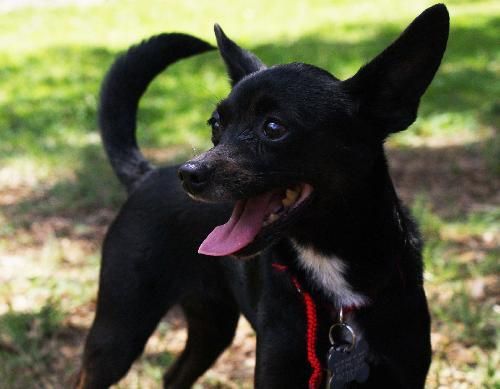
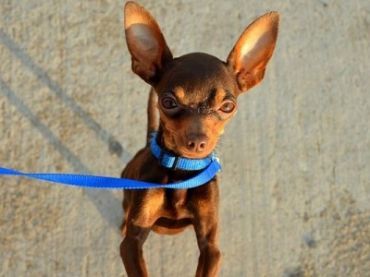
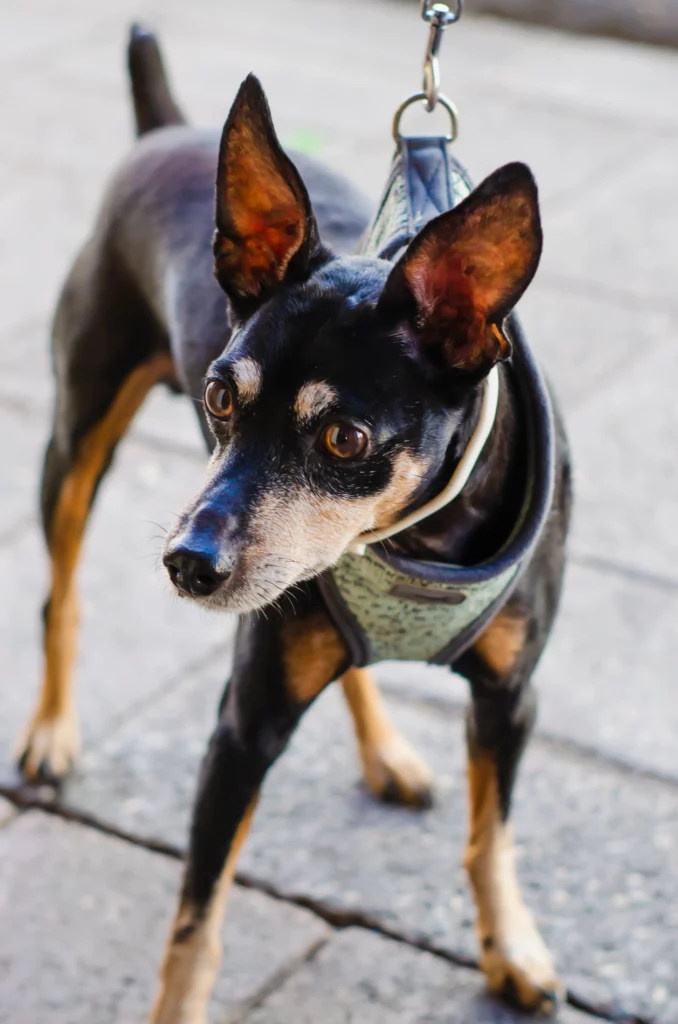
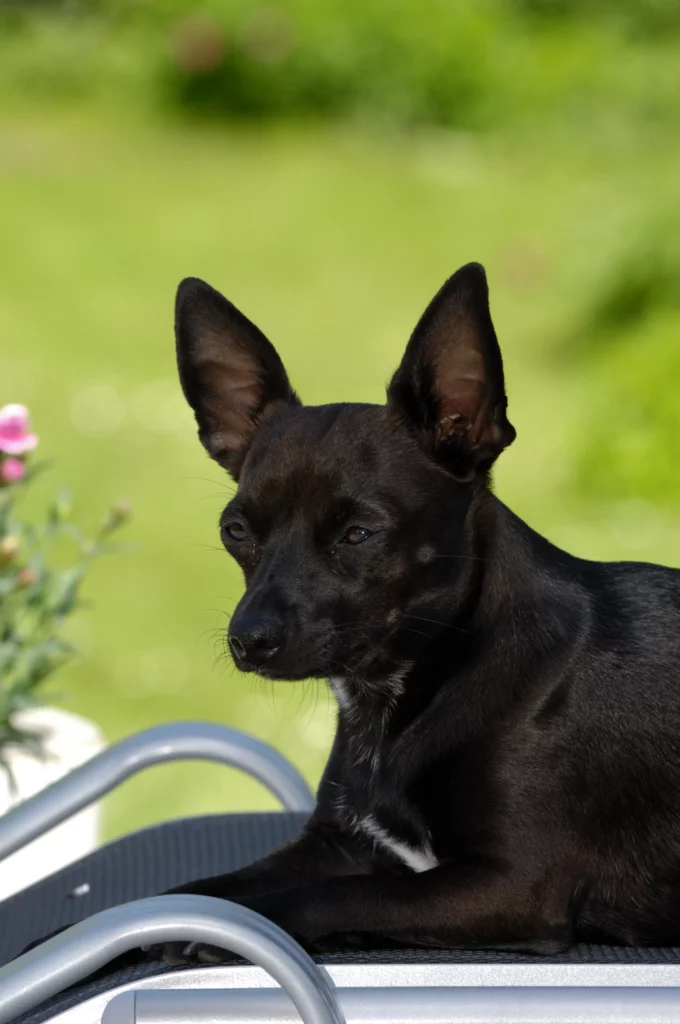
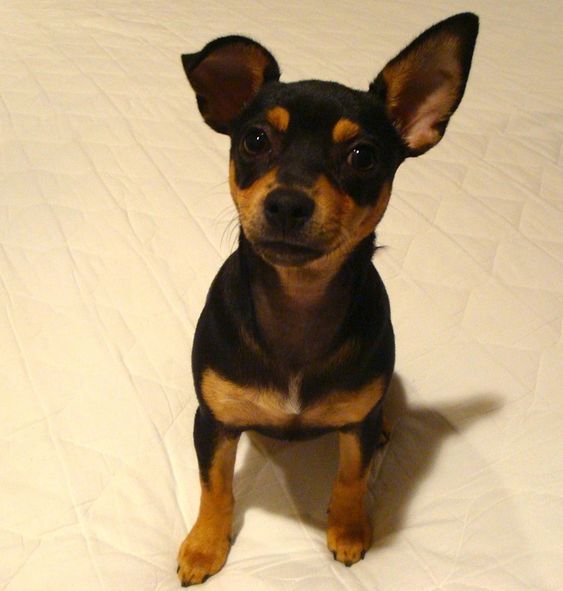
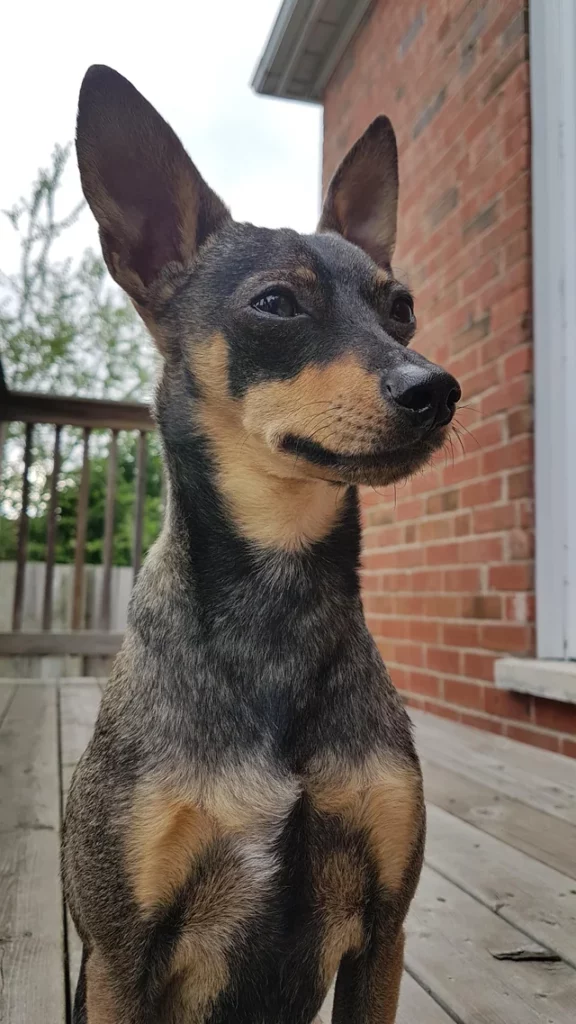
Overview
Chipins may be small, but they pack a lot of spirits, combining the best features of the Chihuahua and the Miniature Pinscher. These mixed-breed dogs are energetic and watchful, perfect for those living in apartments.
Chipins are known for their lively character and need regular playtime and puzzles to keep them sharp. Their short coats come in colors like black, brown, tan, or white, which means less time spent on grooming. Each Chipin has its look, with ears that might stand up or hang down.
Key Chipin Traits
Chipin dogs stand out due to their bright minds and alertness, ability to adapt to various homes, and friendly but cautious approach to meeting new people. The Chipin, created from a mix of Chihuahua and Miniature Pinscher, boasts attributes that make them favorites among dog lovers and pet owners.
| Happy with playtime indoors, playful, and easy to train | Description | Origin |
|---|---|---|
| Ear Type | It can be upright or floppy | Chihuahua/Min |
| Coat Colors | Includes black, brown, tan, white | Designer breed |
| Adaptability | Great for apartment living | Puppy Chihuahua/Min |
| Activity Level | Happy with playtime indoors, playful and easy to train | Designer breed |
| Social Disposition | Loves family, may be reserved with strangers | Chihuahua/Min |
A close look at Chipins shows they have a well-rounded mix of personality and physical characteristics that cater to a diverse range of owners and living conditions.
Breed Origin and Evolution
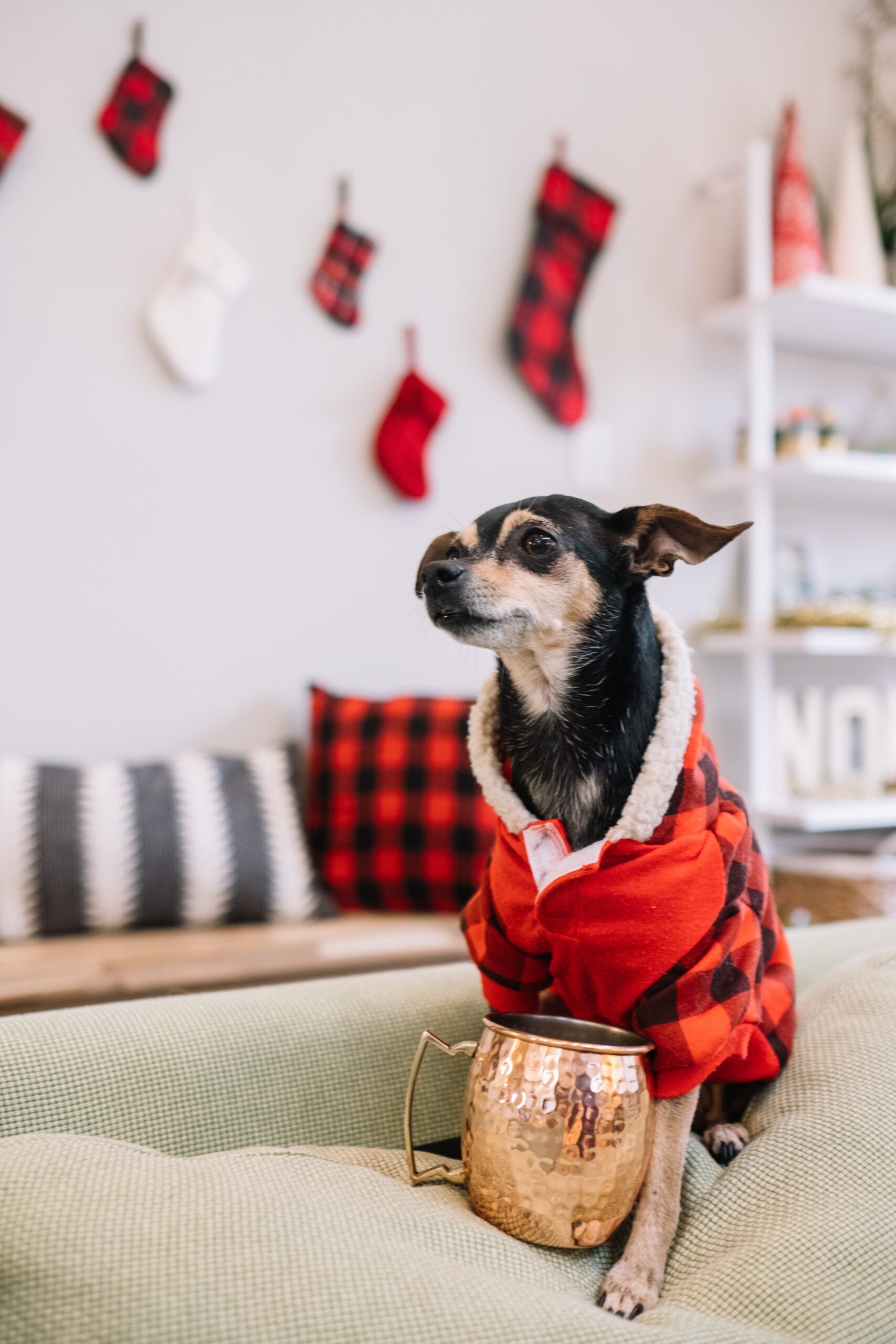
The Chipin is a unique mix, born from the Chihuahua and Miniature Pinscher, with each parent breed passing on its own set of qualities. The Chipin’s history reflects deliberate breeding efforts to merge the best of both sizes and personalities. The resulting dogs exhibit traits favored through selection, highlighting their vigilance and ability to thrive alongside humans, especially in cities.
- Influences from Ancestor Breeds
- Contributions of genes from Chihuahuas
- The influence of Miniature Pinschers on behavior and body structure
- Timeline of Breed Development
- Details on the initial mix of breeds and breeding goals
- The growth in popularity of the species and its steps towards official recognition
- Traits Shaped by Evolution
- Preference for smaller size suited for apartment living
- Behavioral characteristics that foster friendliness and watchfulness
Ancestral Breed Influences
To understand the unique nature of the Chipin dog, it’s necessary to look at the heritage of its parent breeds. The Chihuahua brings its small stature and lively personality to the mix, having its roots in Mexico.
On the other hand, the Miniature Pinscher, initially bred in Germany for catching pests, adds a bold and dynamic character.
The combination of these breeds gives the Chipin its signature alertness and spirit. According to Dog Breed Info, the fusion of the Chihuahua and Miniature Pinscher’s genes leads to various physical features, such as different coat colors and patterns.
As Chipins are bred over multiple generations, these characteristics become even more varied, resulting in a wide array of looks that perfectly represent their mixed heritage.
Historical Development Timeline
The Chipin breed emerged at the end of the 20th century, blending the Chihuahua and the Miniature Pinscher. This crossbreed was designed to merge the Chihuahua’s small stature and lively nature with the Miniature Pinscher’s confident character.
As breeders continued to mix these dogs, they created Chipins with varying levels of purebred heritage, leading to a diverse array of looks, sizes, and coats. This variety has also given rise to various personalities within the breed.
Chipins have steadily become more popular, and some breed registries have started to recognize them, though not all kennel clubs have followed suit.
Evolutionary Adaptation Traits
Born from intentional crossbreeding in the late 20th century, the Chipin dog breed has evolved traits from its Chihuahua and Miniature Pinscher ancestors. The Chipin stands out with its small size from the Chihuahua side and the energetic personality typical of Miniature Pinschers.
Over several generations, this mix has led to various physical features and behaviors. These variations include coat types and behavioral traits that make Chipins versatile and great for family life. Their diverse characteristics have been selected to make them friendly and adaptable pets for modern homes.
Physical Dimensions

Knowing the physical dimensions of Chipins, such as height and weight, is critical to ensuring they stay healthy and are a good match for your home. If you’re considering getting one, you’ll want to know that adult chunks typically stand about 7-12 inches tall and weigh between 5-11 pounds.
Understanding how big Chipins get compared to their Chihuahua and Miniature Pinscher parents or similar small breeds helps determine if they’re the right size for you. Tracking their growth and maintaining an optimal weight is essential for their health, as being overweight can lead to problems for these little dogs.
Height and Weight
Chipins typically stand between 7 to 12 inches tall and weigh 5 to 11 pounds. This small stature is a natural result of combining the genes of Chihuahuas with Miniature Pinschers.
Compact and fitting for city living, Chipins make great companions for those in smaller homes or apartments. Owners should pay attention to Chipin’s diet to prevent weight gain, as these energetic dogs are healthiest with regular exercise and a well-managed diet.
Knowing the expected size of these dogs helps breeders and pet owners look after their health and ensure they lead happy lives.
Breed Size Comparison
Chipins is a charming mix between the tiny Chihuahua and the smaller Miniature Pinscher. With weights ranging from 5 to 11 pounds and heights of 7 to 12 inches, Chipins are a well-suited choice for those living in smaller spaces like apartments.
Their size reflects the mixed inheritance from their parent breeds. Proper care for these small dogs includes diet monitoring and regular exercise to prevent extreme weight loss or obesity.
If a Chipin inherits the longer coat from the Chihuahua side, it will require additional grooming to keep their skin in good condition.
Growth Rate Patterns
Chipins, a mix of Chihuahua and Miniature Pinscher breeds, typically see a significant portion of their growth within their first year. They usually reach a size close to that of an adult dog by the time they are six to nine months old. Their growth rate starts with a rapid gain in size and weight in the early months, then levels off as they near full maturity. This growth pattern results from the genetic traits passed down from their parent breeds.
The term ‘small dog syndrome’ is often linked to how a dog acts, but it’s worth noting that being smaller can make Chipins work more assertively to make up for their size. So, it’s not just about predicting how big a Chipin will get but also preparing for possible behavioral traits. Understanding how Chipins grow is critical to ensuring they develop healthily and happily.
Ideal Weight Range
Chipins should aim to weigh between 5 and 11 pounds to stay healthy for their size. Because they are small dogs, they need to be light and quick, which is why their weight matters.
Their ideal weight considers individual differences and their Chihuahua and Miniature Pinscher heritage.
To keep a Chipin at a healthy weight, it’s essential to feed them a well-balanced diet and to keep them active. This helps them to live comfortably in smaller homes and reduces their risk of health problems caused by being overweight.
Keeping an eye on their weight regularly is critical to their health and happiness.
Structural Breed Characteristics
Examining the physical traits of Chipins, these small dogs stand between 5 to 11 inches tall at the shoulder. This height reflects their Chihuahua and Miniature Pinscher ancestry. Chipins have a sturdy yet compact frame that suits their small stature. Their bodies are well-balanced, and their heads show the distinctive apple or deer shape, ending in a pointed muzzle—a nod to their mixed heritage.
Chipins are known for their short coats in various colors, such as black, brown, tan, and white, which are easy to care for and don’t require much grooming. Their ears, large and reminiscent of bats, might stand erect or hang down, heavily influenced by which parent breed’s genes are more dominant.
Chipin Temperament
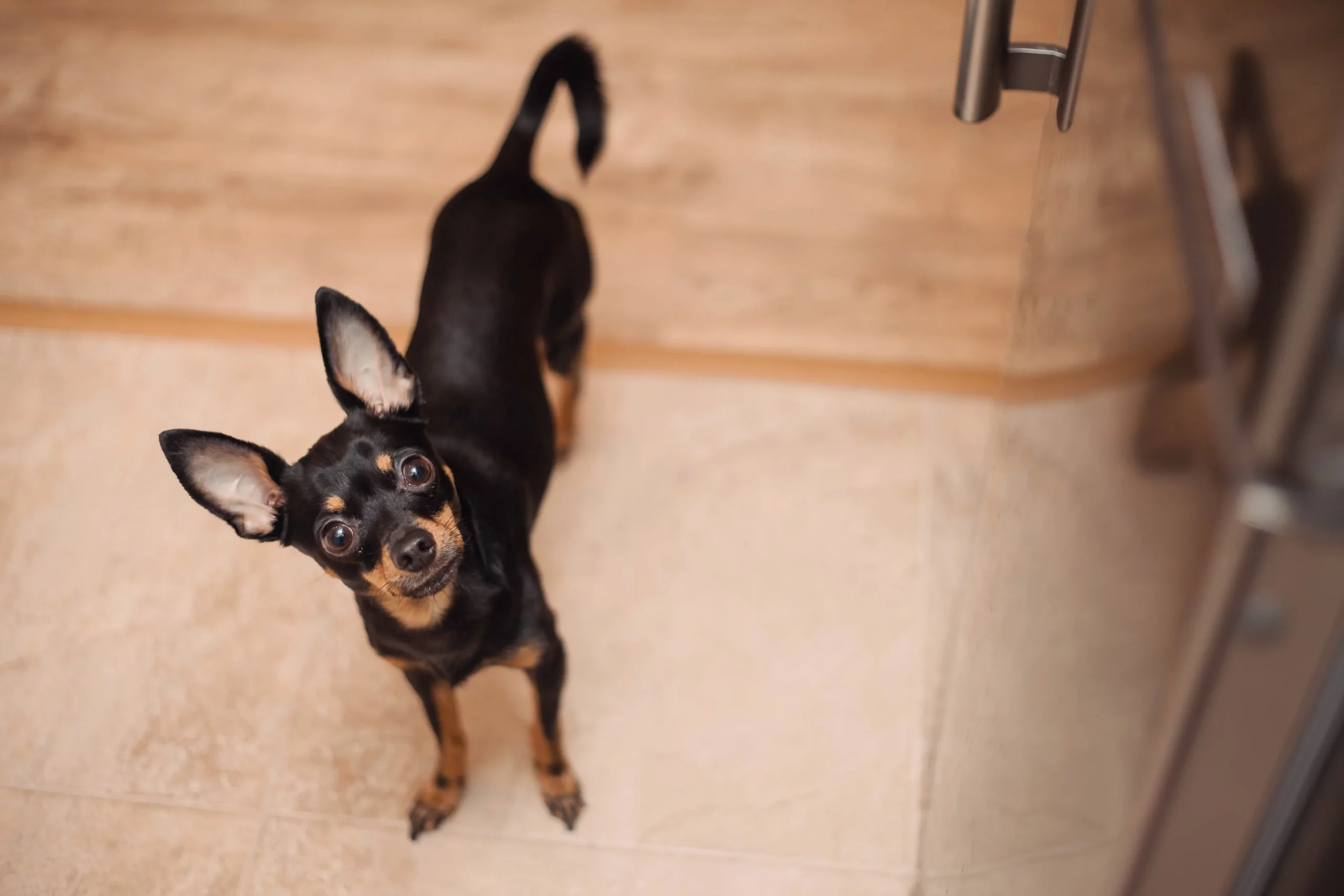
Chipin dogs have a complex temperament that’s shaped by their genetic heritage. This affects how easily they adjust to family life and interact with other animals. Socializing Chipins early is vital to moderate their strong hunting instincts and help develop a well-rounded personality. Training can be a challenge due to their lively and sometimes willful behavior.
Socialization is critical to ensuring Chipins get along with different people and environments. Training helps to prevent any negative behavior towards smaller pets. It lays the groundwork for obedience and adapting well to various situations. When considering a Chipin as a pet, consider how it fits with children and other animals in your home. They demand attention and are quite affectionate. You’ll need to manage their high energy levels within your household routine.
Understanding and managing Chipin’s instinct to chase is crucial. Regular and consistent training is needed to keep this behavior in check. Please provide them with ample activities that allow them to burn off energy positively.
Socialization Importance
Socializing your Chipin is vital in helping them get along with people and other animals. A well-socialized Chipin is likely to be more even-tempered, adaptable, and less anxious when faced with new experiences. Introduce your Chipin to places, people, and animals early to build their confidence and comfort. This helps overcome their natural cautiousness around unfamiliar faces and improves their friendliness.
Social skills also allow Chipins to fit into family life more quickly, making them good companions for children and other pets in the home.
Family Compatibility
Chipins, a mix of Chihuahua and Miniature Pinscher breeds, often adjust remarkably well to family life, especially with early training and exposure to different people and situations. These small dogs bring energy and affection to a home. They’re adaptable to various living spaces, from apartments to houses with yards.
With the proper guidance, Chipins can build strong bonds with respectful older children and even get along with other pets. This enriches your family with their spirited personality and love.
Prey Drive Management
Training Chipins to manage their natural prey drive is crucial for a peaceful home, especially if you have other pets or live near wildlife. A well-planned training routine helps these dogs learn self-control and follow commands. Introducing Chipins to various animals early on helps reduce their urge to chase after them. This should be done in a safe and monitored environment. Regularly exercising and mentally challenging your Chipin can also help direct their energy positively, preventing unwanted hunting behaviors.
Creating a supportive environment that rewards good behavior is critical. When your Chipin interacts gently with other animals, positive reinforcement is a great way to encourage that behavior. This approach helps Chipins learn to live amicably with different pets.
Behavioral Traits
Chipins are a lively mix of their Chihuahua and Miniature Pinscher ancestors, showing a unique blend of qualities that defines their personality. Curiosity drives these dogs, making them attentive to their surroundings and willing to join in activities. They inherit their vigilance from the Chihuahua side, while their Miniature Pinscher roots give them a bold confidence.
These dogs learn quickly and thrive with regular training that taps into their smartness. They need activities that challenge their minds and keep them active to prevent boredom. A well-planned socialization and training routine is critical to helping Chipins reach their full potential as loyal pets.
Training Challenges
Training a Chipin can be a test of your patience and consistency. Their intelligent and self-reliant characteristics might make them a bit obstinate during training. As an owner, finding the right way to guide them is vital, especially with their tendency to be determined.
Chipins have a lot of energy, so it’s necessary to keep training sessions active and engaging to hold their interest and prevent them from getting sidetracked.
To train a Chipin effectively, you should be a calm and firm leader. This helps manage their instinct to chase and promotes good behavior. Using their natural alertness and quick reactions in a positive way can turn these traits into strengths during structured exercises.
Introducing them to different people and settings early on, along with consistent positive feedback, helps address these training challenges and leads to a well-behaved Chipin.
Health Concerns & Management
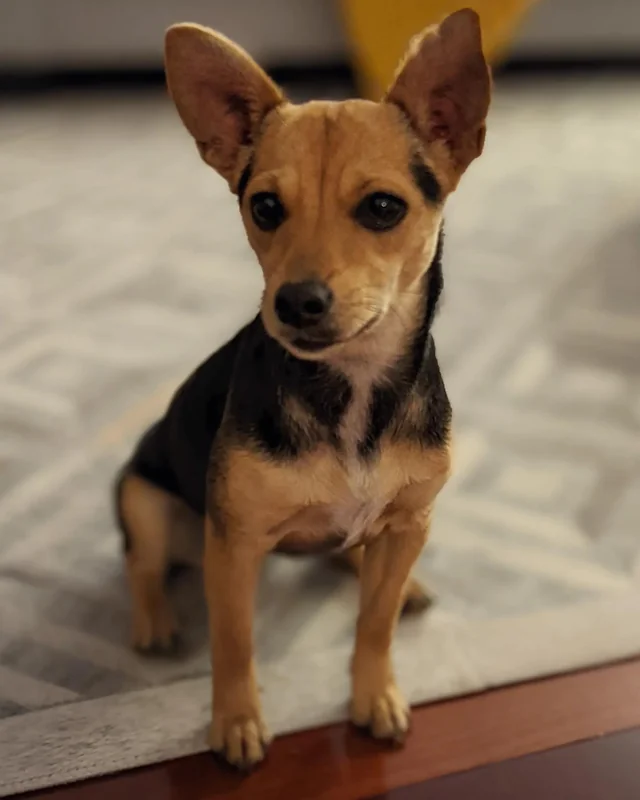
The Chipin, a mix of the Chihuahua and Miniature Pinscher, comes with its own health concerns that owners must watch. Staying on top of preventative care can help prevent inherited health issues. At the same time, a balanced diet and regular exercise can keep a Chipin at a healthy weight and lower the risk of obesity-related problems. The lifespan of a Chipin often depends on their genes and the level of care they receive, showing the importance of a consistent health management routine.
- Common Health Issues
- Knee problems such as Patellar Luxation
- Congenital Heart Defects
- Eye conditions like Progressive Retinal Atrophy
- Preventative Care
- Consistent vet check-ups
- Timely vaccinations and protection against parasites
- Good dental care practices
- Factors Affecting Lifespan
- Genetic health background
- Quality of diet
- Amount of physical activity
Owners can help their Chipins live fuller, healthier lives by being proactive with these health practices.
Common Genetic Conditions
Chipins, a crossbreed of Chihuahuas and Miniature Pinschers, often inherit certain health conditions. These small dogs can suffer from patellar luxation, where the kneecap slips out of place, causing pain and potential mobility issues.
Good dental care is crucial as they are prone to periodontal disease, which Chihuahuas commonly face. Regular teeth cleaning is vital to preventing severe dental problems.
Additionally, Chipins tend to become overweight. Managing their diet and ensuring they get enough exercise are essential to keep them healthy.
Regular check-ups with a vet and a customized health plan can significantly improve Chipin’s well-being.
Preventative Health Measures
Chipins, a crossbreed of Chihuahuas and Miniature Pinschers, thrive when they receive consistent care. A well-balanced diet, regular physical activity, and ongoing veterinary oversight are vital to keeping them healthy.
To prevent unwanted weight gain, which Chipins are prone to, it’s vital to stick to a strict feeding schedule. Daily exercise is also a must for these small dogs – it helps maintain a healthy weight, supports heart health, and provides mental stimulation to keep them happy.
Routine vet visits are crucial for spotting any inherited health issues early on. Taking care of their teeth with regular brushing is non-negotiable; it helps fend off dental diseases that could otherwise impact their overall health. Keeping up with their grooming and trimming their nails will keep their coat shiny and skin healthy and aid in their movement.
When Chipins are around children, close supervision is wise to prevent accidental harm.
Lifespan Expectancy Factors
Knowing what affects the lifespan of Chipins is crucial because, with proper care, they can enjoy a life of 13 to 16 years. Due to their mixed heritage, these small dogs are prone to gaining weight and dental problems. To help them avoid obesity, which is common, it’s vital to keep them active and monitor their diet closely. Consistent feeding times help keep their weight in check and require owners to be attentive.
Regular grooming and dental hygiene are critical to Chipin’s health. Although their coats are short, they need regular brushing to avoid skin issues. Early socialization and consistent training also play a significant role in managing their energetic nature. Without it, they may experience stress, which can affect their health.
Maintenance Essentials
Caring for a Chipin, a mix between a Chihuahua and a Miniature Pinscher, involves a holistic approach focusing on both body and mind. Setting up a regular grooming routine and a feeding plan that suits their energy needs is vital to keep them healthy and lively. Regular health check-ups, practical training, and enough exercise are essential to Chipin’s care.
Tips for Grooming:
- How often do you brush and give baths
- Keeping teeth clean
- When to trim nails
Feeding Plans That Work:
- Adjust calories based on how active they are
- Please make sure they get the right balance of nutrients
- Keep meal times consistent
Keeping Them Healthy:
- Take them for vet visits often
- Watch out for health issues common to the breed
- Don’t skip on preventative care
For a Chipin, brushing their coat a few times a week and bathing them when necessary keeps their fur in good condition. Dental care is more than just fresh breath; it prevents disease, so regular teeth cleaning is needed. Trimming their nails every couple of weeks prevents discomfort and mobility issues.
Regarding their diet, matching their caloric intake with how much exercise they get prevents weight issues. A balanced diet with the proper nutrients supports overall well-being. Sticking to regular meal times helps prevent digestive problems.
Health-wise, taking your Chipin for vet check-ups often is wise to catch any issues early. Some health problems are more common in certain breeds, so vigilance is vital. Also, keeping up with vaccinations and other preventative treatments safeguards their health.
Grooming Routine Tips
Taking care of a Chipin’s coat and overall hygiene is vital to their health and happiness.
Chipins possess a sleek, short coat that doesn’t shed much, but regular grooming is still essential. Aim to brush their coat weekly to keep it clean and spread the dog’s natural oils, which makes its coat shiny.
Regarding baths, giving your Chipin one every month with a gentle shampoo for dogs will help avoid skin issues.
Nail care is another essential aspect of grooming; trim their nails every 3 to 4 weeks and be cautious to avoid the sensitive quickly.
Also, don’t forget about dental care; regular teeth cleaning can prevent gum disease and keep your Chipin’s mouth healthy.
Attention to these grooming details will help your energetic Chipin stay in great shape.
Optimal Feeding Schedules
Creating a feeding schedule for a Chipin can do wonders for their health and energy levels. Since they’re a small breed, they must manage their diet carefully to prevent weight gain. They need just the right amount of food to fuel their fast metabolism and keep them at a healthy weight.
Watching the portion size is critical for these little dogs since overfeeding can easily lead to obesity. When planning meals, consider the dog’s age, how active they are, and any unique health needs they might have.
Regular meal times help keep their metabolism and digestion in good shape. Pairing controlled food portions with regular exercise is the best way to keep a Chipin happy and healthy for years.
Health Check Priorities
Chipins, a blend of Chihuahua and Miniature Pinscher breeds, are typically strong dogs. Regular vet visits are vital to catch and manage inherited health issues early on. They may be prone to certain conditions like dental problems, kneecap dislocations, and heart concerns due to their mixed heritage. Tracking their physical activity is essential to avoid weight gain, which can worsen these conditions.
During veterinary examinations, it’s crucial to have a thorough check of their heart, joints, and teeth. Paying close attention to their health can prevent more significant issues. It’s wise to follow a vet-approved plan for their diet and exercise, taking proactive steps to maintain their well-being and reduce the risk of genetic disorders.
Training Techniques
Training your Chipin effectively is crucial in shaping its behavior and helping it thrive daily. Studies on canine behavior highlight the need for training methods that build clear communication and trust between you and your dog. For Chipins, these methods are vital to reduce excessive barking and promote polite behavior—qualities particularly beneficial if you live in a small space like an apartment.
Positive reinforcement should be the cornerstone of your training approach, steering clear of harsh methods to cultivate a bond based on respect. This strategy reinforces good behavior and establishes you as a trusted leader in your dog’s eyes.
Regular training also allows you to monitor Chipin’s health, ensuring that hereditary health issues are managed well. Including physical activity in your training routine is essential for maintaining a healthy weight and overall wellness for your Chipin.
Exercise Recommendations
Chipins thrive when they get at least 45 minutes of exercise daily. This can be through walks, playing fetch, or specialized agility training. Regular physical activity keeps them fit and prevents health issues like obesity. After a long day, a good run or play session helps your Chipin burn off excess energy and keeps their metabolism in check.
Adding agility training to their routine a few times a week sharpens their mind and improves their coordination. This training ensures your Chipin stays physically and mentally engaged, contributing to their overall happiness and health.
For Chipins to lead a whole and energetic life, sticking to a regular exercise plan is vital.
Dietary Requirements
When feeding Chipins, it’s vital to consider their high energy levels and smaller size. Choosing the right food is critical, especially since they are active and may have specific dietary needs or food sensitivities.
To keep them healthy, it’s wise to pay attention to how often they eat, matching their meal schedule with their fast metabolism.
For the best nutrition, look for foods high in protein to support muscle health and include balanced levels of omega fatty acids to keep their coat shiny.
If you suspect your Chipin has allergies, trying an elimination diet is a good idea to pinpoint the cause. Manage their calorie intake based on how much exercise they get and stick to regular feeding times to help their metabolism run smoothly.
Optimal Food Choices
Choosing the proper diet for your Chipin is critical to their well-being and energy. These small dogs need meals that keep them active but don’t cause weight gain.
A specialized diet for toy breeds is best, with plenty of high-quality proteins, complex carbs for lasting energy, and fats for a healthy coat. Measuring their food and following a feeding schedule is essential to avoid overeating.
Vitamins and minerals are also vital for their immune system, and regular exercise should go hand in hand with their nutrition to keep them in great shape.
Allergies and Sensitivities
Chipins, the energetic mix of Chihuahua and Miniature Pinscher, often have food sensitivities that require owners to be selective with their meals. These dogs need diets tailored to their needs, as they might react badly to certain foods. Because of their vibrant energy, they need high-quality food; however, too much food can cause weight gain and additional health problems.
Owners should watch their Chipins closely for any signs of discomfort or allergic reactions after eating. It’s vital to regularly assess and adjust your dog’s diet to weed out any harmful ingredients. This careful monitoring helps maintain their overall health and meets their dietary needs without triggering adverse reactions.
Feeding Frequency Recommendations
Chipin owners should feed their small and active dogs in a way that fuels their energy without leading to weight gain. For these dogs, it’s best to spread their daily food into two or three meals. This approach helps to manage their hunger and energy throughout the day without straining their digestive system.
Regular meal times help Chipins get used to eating at specific moments, preventing them from overeating and ensuring they get the most out of their nutrition. Monitoring how much you give them at each meal is vital to avoid accidental overfeeding, a common issue for many pet owners.
Given their high activity levels, Chipins benefit from a feeding schedule that supports their lively lifestyle while keeping excess pounds off.
